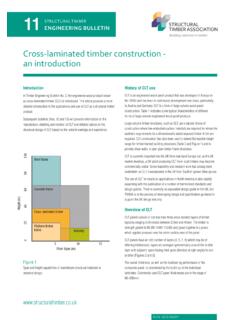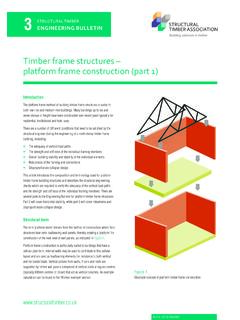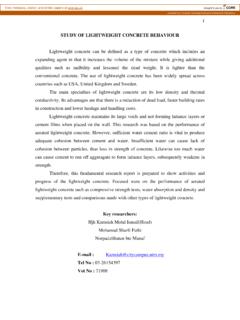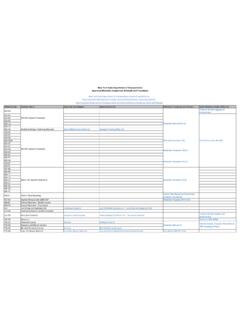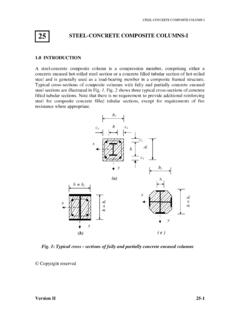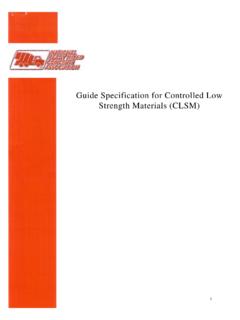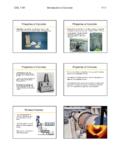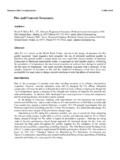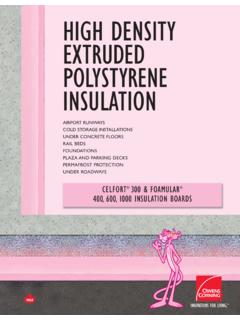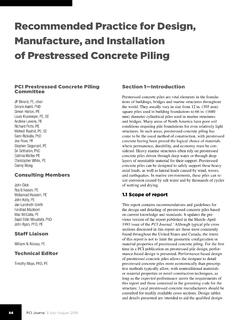Transcription of Timber as a structural material - an introduction
1 The use of Timber as a structural material is not new, in fact dating back many centuries. As time passes, developments in the various types of Timber components which are available and their use in different structural forms have occurred; new advanced Timber products are now available enabling structural engineers to achieve the performance and effi ciency in building forms being demanded in the 21st are thousands of species of tree from which Timber can be obtained, each with diff erent rates of growth, structural properties and degrees of durability. The Timber supply chain has responded to nature s variability and now provides repeatable product supply from managed forests. The industry has also created grading processes to deliver reliable technical performance (grades) for these UK construction industry generally uses the word Timber to describe structural products of wood, whereas in North America the word lumber is used.
2 Wood is often used to describe furniture and other non- structural items. Nevertheless, all three terms are commonly used to describe structural is categorised as either softwood or hardwood . Softwood is obtained from coniferous trees and hardwood comes from broad-leaved trees. Softwood and hardwood are botanical terms and do not necessarily refer to the density or hardness of the wood. For example Balsa, which is known to be soft and used for building lightweight models, is a hardwood whereas Douglas Fir is a softwood with good durability and high strength is commonly used for Timber structures (Figure 1) as it is readily available, easily worked, of relatively low cost and its fast rate of growth gives a continuous supply from regenerated forest are typically used for exposed structures and claddings where durability and particular aesthetic characteristics, such as colour or grain pattern, are 0 - as a structural material - an TIMBERENGINEERING BULLETIN1 Figure 1 Softwood Timber frame construction using prefabricated floor cassettes History of useIn the United Kingdom, Timber was the principle construction material for buildings in the Medieval period until the 18th century.
3 After the Great Fire of London in 1666, masonry was used increasingly for external and separating walls with structural Timber employed for roofs, floors and internal was typically used for Timber -framed buildings during the medieval period due to its availability, while softwoods from the Baltic countries and North America were increasingly employed for internal structural Timber , floors and roofs within masonry buildings from the 18th century the increasing use of iron in buildings in the 19th century, Timber was used in combination with metal for long span and heavily loaded structures. The development of mathematical procedures at this time for the design of structures and structural elements (Figure 2) led to today s approach to engineering Timber structures (Figure 3).Table 1 shows the evolution of the use of Timber in buildings. For more information on these historic forms of construction, refer to the References and further reading use Timber for today s structures?
4 Energy issuesAs a natural and renewable building material , Timber has excellent ecological attributes. It acts as a carbon sink and has low embodied energy. The energy needed to convert trees into wood and hence into structural Timber is significantly lower than that required by other structural materials such as steel and concrete. Figure 4 compares the production energy requirements for lightweight concrete block and Timber frame walls. This point is further demonstrated by comparing the energy requirements for beams in steel, reinforced concrete and Timber , as illustrated in Figure TIMBERENGINEERING BULLETIN12 REV 0 - 1: Historic use of Timber and structural forms in buildingsTable 2: Characteristic strength , stiffness and densityproperties for typical softwoods from EN 338 Table 1 Figure 2 Early 20th Century Timber post and beam and truss construction subjected to high wind loads. Model of the climatology and research station located at 4000m above sea level at Jungfraujoch, SwitzerlandFigure 3 Multi-storey Timber frame construction using platform frame methodsOther benefits of Timber material can be easily shaped and modified - waste material can be recycled it can be easily connected using nails, screws, dowels, bolts and connectors - under controlled conditions of temperature and humidity adhesives may be used to glue Timber elements together Timber (and Timber components) is lightweight and easy to handle in manufacture, transport and constructionStrength of timberWhen compared to other structural materials, softwood Timber has a low density (Table 2).
5 This means it can offer lightweight structural solutions resulting in benefi ts such as reduced foundation loads and ease of lifting prefabricated elements during transportation and strength of Timber comes from the natural properties of the wood and the way the tree grows (Figure 8). Standard Timber joists are sawn from the trunk of a tree. The trunk is composed of cells aligned axially along the trunk, which are long in relation to their width. Timber joists and beams sawn from the trunk of the tree have these cells parallel to their length and this provides both the axial and flexural strength . The compression and tension strength of Timber parallel to the grain is much greater than that perpendicular to the grain, due to the natural characteristics of these cell strength of sawn Timber is a function of species, density, size and form of member, moisture content and duration of applied loading, together with strength -reducing characteristics such as slope of grain, knots, fissures and wane.
6 strength grading methods have been devised to classify Timber using either visual strength grading or machine strength grading on species, Timber can also have good durability characteristics and good insulating properties against heat and both airborne and impact issuesTimber has a very high strength -to-weight ratio. This is illustrated as a comparison between steel and Timber in Figure considerationsWhen compared to other structural materials, softwood Timber has a low density (Table 2). This means it can off er lightweight structural solutions resulting in benefi ts such as reduced foundation loads and ease of lifting prefabricated elements during transportation and modern buildings are prefabricated in elements off site. As a result there is generally a requirement for less site labour and a reduced programme time for work on site (Figure 7).Prefabrication in a factory gives the opportunity for quality control and avoids the vagaries of the weather and site TIMBERENGINEERING BULLETIN13 REV 0 - 4 Comparison of production energy requirements for Timber frame and lightweight concrete blocksFigure 5 material energy requirements for equivalent beams in common materialsFigure 6 strength -to-weight ratios for a range of Timber grades, glulam and steel< Figure 7 Prefabricated Timber frame wall panels during erectionFor products that require thicknesses above 75mm, the use of multiple sections or engineered wood products (EWPs) are often used, as the appropriate installation moisture content of Timber sections above 75mm thickness is difficult to achieve.
7 Table 3 provides an indication of the section size limits for Timber . Note: engineered wood products, composite wood products and wood-based board materials will be described in more detail in future articles in this strength of Timber comes from the natural properties of the wood and the way the tree grows (Figure 8). Standard Timber joists are sawn from the trunk of a tree. The trunk is composed of cells aligned axially along the trunk, which are long in relation to their width. Timber joists and beams sawn from the trunk of the tree have these cells parallel to their length and this provides both the axial and flexural strength . The compression and tension strength of Timber parallel to the grain is much greater than that perpendicular to the grain, due to the natural characteristics of these cell strength of sawn Timber is a function of species, density, size and form of member, moisture content and duration of applied loading, together with strength -reducing characteristics such as slope of grain, knots, fissures and wane.
8 strength grading methods have been devised to classify Timber using either visual strength grading or machine strength grading content of timberWater in a tree immediately after felling lies within the walls and voids of the cells previously described. When the Timber dries, water is then lost from within the cell voids and there is no dimensional change as the moisture content reduces (m/c is the weight of water to oven dried Timber ) until the fibre saturation point (approximately 25% m/c) is reached when water begins to be lost from the cell walls. Dimensional change, otherwise known as shrinkage, then commences. Likewise when Timber attracts moisture it will swell until fibre saturation is moisture contents (by weight) of Timber in service are in the range 7-12% for internal heated areas, 10-18% for internal unheated areas and 12-26% for exposed UK timbers. The typical moisture content of Timber freshly felled is at least 100% but varies depending on what time of year the tree is felled.
9 BS EN 1995-1-1 defines Timber in service with a moisture content of 12% or less as being in Service Class 1, 20% or less in Service Class 2 and above 20% as Service Class of similar strength properties are grouped together into a series of strength classes which are defi ned in BS EN 338:2009. This simplifies the design and specifi cation process by enabling designs to be based on defi ned strength class limits without the need to identify and source a particular species and grade combination. strength classes are defi ned as softwoods prefixed C (coniferous) and hardwoods prefixed D (deciduous). The values for commonly available softwood grades are indicated in Table 2 (note that the TR26 grade is a UK grade typically for truss rafter roofs and open web floor joists derived from C27 material Figure 9).Size of timberSoftwood Timber sections tend to be produced in a range of standard sizes and lengths called customary sizes.
10 These are listed in BS EN 336: 2003 and its UK National information on common softwood Timber joist sizes is given in the IStructE Technical Guidance Note 18 (Level 1) Design of Timber floor TIMBERENGINEERING BULLETIN14 REV 0 - ringEarly woodLate woodTransverse faceTrangential faceRadial faceResin ductTracheidRayFigure 8 Structure of softwood (Courtesy of TRADA Technology Ltd)Figure 9 Open web floor joists using TR26 Timber for flangesTable 3: Section size limits for Timber productsAlternatively, the structural engineer may adopt a specific Timber species for a particular project where natural durability is required, such as exposed Timber columns, bridges and water-containing , the majority of Timber structures adopt Timber materials that are assumed not to be durable and therefore, it is the design of the structure itself which plays the most important part, to ensure that the Timber is not susceptible to high moisture contents in service, giving rise to the potential for moisture content of Timber can affect the strength and stiffnessproperties and generally, Timber strength increases with decreasingmoisture content values.

